Teamwork, Group Formation and Decision Making in HRM Essay
VerifiedAdded on 2020/01/21
|11
|3316
|83
Essay
AI Summary
This essay delves into the significance of teamwork within various organizational contexts, emphasizing its impact on employee performance, commitment, and overall business success. It explores the advantages of collaborative work environments and the importance of effective group formation, drawing upon examples such as Aldi. The essay examines different types of groups, including formal and informal structures, as well as the stages of group development. It also discusses the impact of group dynamics, including norms, conformity, and decision-making processes. The essay highlights the role of leadership in managing conflicts and fostering a positive team environment. Furthermore, it addresses the influence of group size on performance and the various techniques used in group decision-making, such as brainstorming and the Delphi method. By analyzing these elements, the essay underscores the critical role of teamwork in achieving organizational goals and objectives.
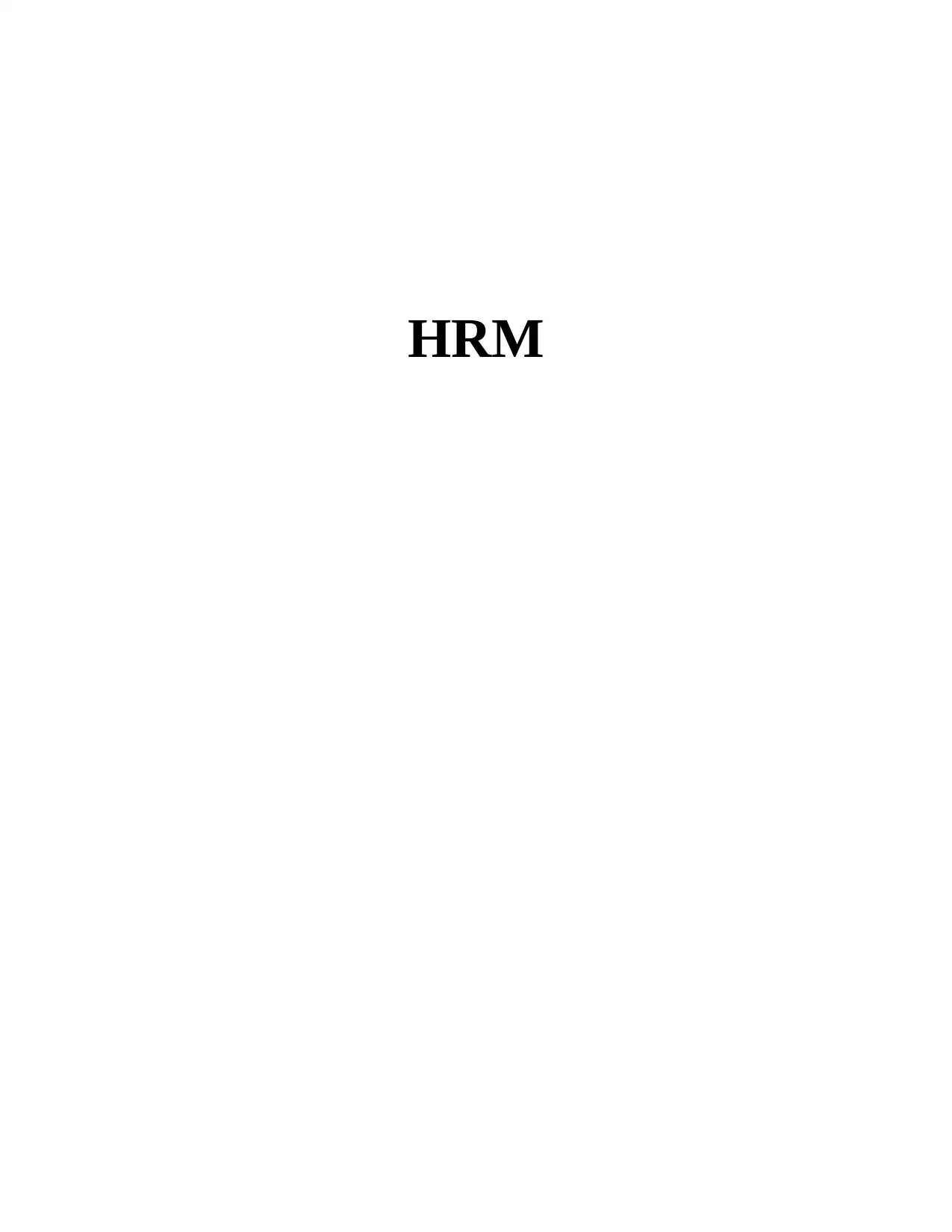
HRM
Paraphrase This Document
Need a fresh take? Get an instant paraphrase of this document with our AI Paraphraser

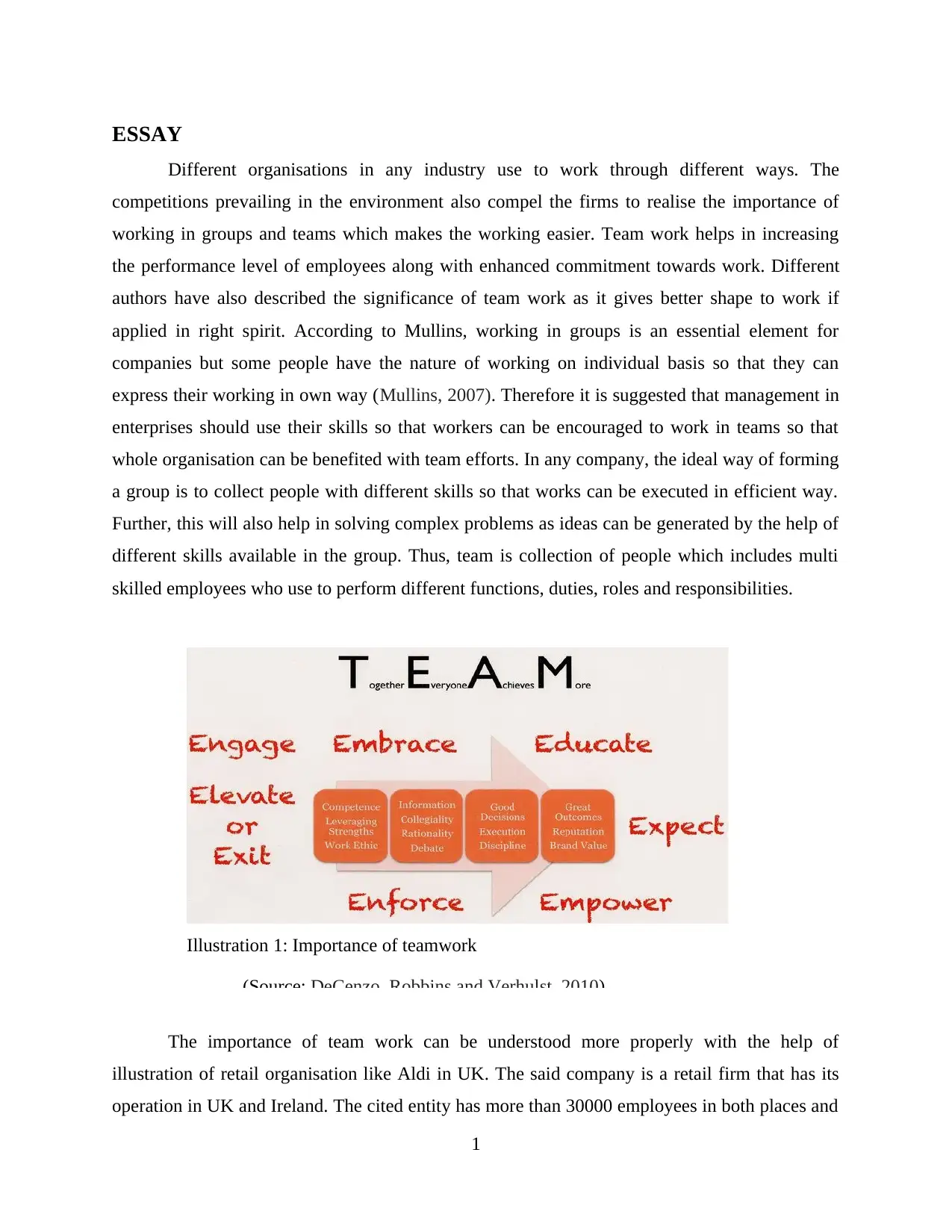
ESSAY
Different organisations in any industry use to work through different ways. The
competitions prevailing in the environment also compel the firms to realise the importance of
working in groups and teams which makes the working easier. Team work helps in increasing
the performance level of employees along with enhanced commitment towards work. Different
authors have also described the significance of team work as it gives better shape to work if
applied in right spirit. According to Mullins, working in groups is an essential element for
companies but some people have the nature of working on individual basis so that they can
express their working in own way (Mullins, 2007). Therefore it is suggested that management in
enterprises should use their skills so that workers can be encouraged to work in teams so that
whole organisation can be benefited with team efforts. In any company, the ideal way of forming
a group is to collect people with different skills so that works can be executed in efficient way.
Further, this will also help in solving complex problems as ideas can be generated by the help of
different skills available in the group. Thus, team is collection of people which includes multi
skilled employees who use to perform different functions, duties, roles and responsibilities.
The importance of team work can be understood more properly with the help of
illustration of retail organisation like Aldi in UK. The said company is a retail firm that has its
operation in UK and Ireland. The cited entity has more than 30000 employees in both places and
1
Illustration 1: Importance of teamwork
(Source: DeCenzo, Robbins and Verhulst, 2010)
Different organisations in any industry use to work through different ways. The
competitions prevailing in the environment also compel the firms to realise the importance of
working in groups and teams which makes the working easier. Team work helps in increasing
the performance level of employees along with enhanced commitment towards work. Different
authors have also described the significance of team work as it gives better shape to work if
applied in right spirit. According to Mullins, working in groups is an essential element for
companies but some people have the nature of working on individual basis so that they can
express their working in own way (Mullins, 2007). Therefore it is suggested that management in
enterprises should use their skills so that workers can be encouraged to work in teams so that
whole organisation can be benefited with team efforts. In any company, the ideal way of forming
a group is to collect people with different skills so that works can be executed in efficient way.
Further, this will also help in solving complex problems as ideas can be generated by the help of
different skills available in the group. Thus, team is collection of people which includes multi
skilled employees who use to perform different functions, duties, roles and responsibilities.
The importance of team work can be understood more properly with the help of
illustration of retail organisation like Aldi in UK. The said company is a retail firm that has its
operation in UK and Ireland. The cited entity has more than 30000 employees in both places and
1
Illustration 1: Importance of teamwork
(Source: DeCenzo, Robbins and Verhulst, 2010)
⊘ This is a preview!⊘
Do you want full access?
Subscribe today to unlock all pages.

Trusted by 1+ million students worldwide
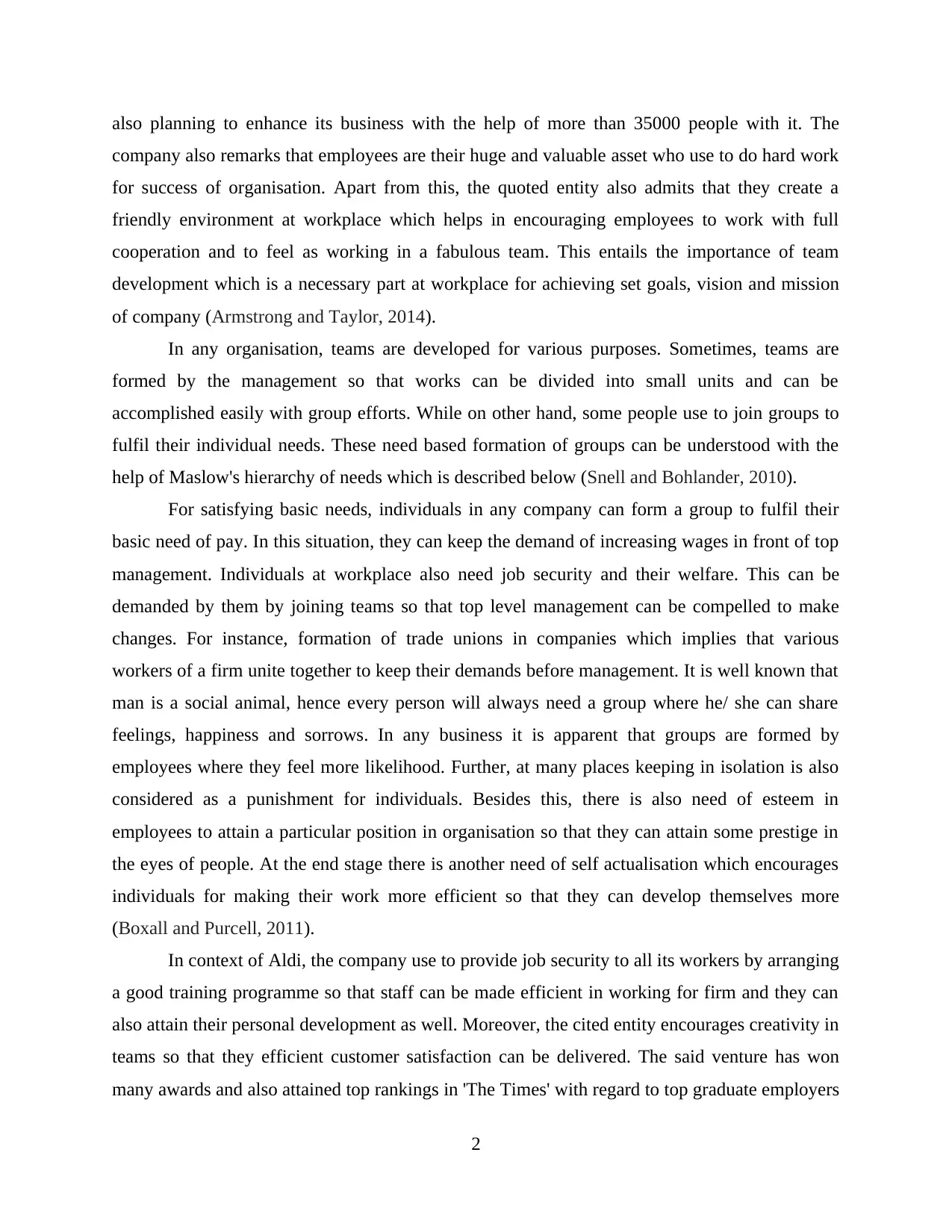
also planning to enhance its business with the help of more than 35000 people with it. The
company also remarks that employees are their huge and valuable asset who use to do hard work
for success of organisation. Apart from this, the quoted entity also admits that they create a
friendly environment at workplace which helps in encouraging employees to work with full
cooperation and to feel as working in a fabulous team. This entails the importance of team
development which is a necessary part at workplace for achieving set goals, vision and mission
of company (Armstrong and Taylor, 2014).
In any organisation, teams are developed for various purposes. Sometimes, teams are
formed by the management so that works can be divided into small units and can be
accomplished easily with group efforts. While on other hand, some people use to join groups to
fulfil their individual needs. These need based formation of groups can be understood with the
help of Maslow's hierarchy of needs which is described below (Snell and Bohlander, 2010).
For satisfying basic needs, individuals in any company can form a group to fulfil their
basic need of pay. In this situation, they can keep the demand of increasing wages in front of top
management. Individuals at workplace also need job security and their welfare. This can be
demanded by them by joining teams so that top level management can be compelled to make
changes. For instance, formation of trade unions in companies which implies that various
workers of a firm unite together to keep their demands before management. It is well known that
man is a social animal, hence every person will always need a group where he/ she can share
feelings, happiness and sorrows. In any business it is apparent that groups are formed by
employees where they feel more likelihood. Further, at many places keeping in isolation is also
considered as a punishment for individuals. Besides this, there is also need of esteem in
employees to attain a particular position in organisation so that they can attain some prestige in
the eyes of people. At the end stage there is another need of self actualisation which encourages
individuals for making their work more efficient so that they can develop themselves more
(Boxall and Purcell, 2011).
In context of Aldi, the company use to provide job security to all its workers by arranging
a good training programme so that staff can be made efficient in working for firm and they can
also attain their personal development as well. Moreover, the cited entity encourages creativity in
teams so that they efficient customer satisfaction can be delivered. The said venture has won
many awards and also attained top rankings in 'The Times' with regard to top graduate employers
2
company also remarks that employees are their huge and valuable asset who use to do hard work
for success of organisation. Apart from this, the quoted entity also admits that they create a
friendly environment at workplace which helps in encouraging employees to work with full
cooperation and to feel as working in a fabulous team. This entails the importance of team
development which is a necessary part at workplace for achieving set goals, vision and mission
of company (Armstrong and Taylor, 2014).
In any organisation, teams are developed for various purposes. Sometimes, teams are
formed by the management so that works can be divided into small units and can be
accomplished easily with group efforts. While on other hand, some people use to join groups to
fulfil their individual needs. These need based formation of groups can be understood with the
help of Maslow's hierarchy of needs which is described below (Snell and Bohlander, 2010).
For satisfying basic needs, individuals in any company can form a group to fulfil their
basic need of pay. In this situation, they can keep the demand of increasing wages in front of top
management. Individuals at workplace also need job security and their welfare. This can be
demanded by them by joining teams so that top level management can be compelled to make
changes. For instance, formation of trade unions in companies which implies that various
workers of a firm unite together to keep their demands before management. It is well known that
man is a social animal, hence every person will always need a group where he/ she can share
feelings, happiness and sorrows. In any business it is apparent that groups are formed by
employees where they feel more likelihood. Further, at many places keeping in isolation is also
considered as a punishment for individuals. Besides this, there is also need of esteem in
employees to attain a particular position in organisation so that they can attain some prestige in
the eyes of people. At the end stage there is another need of self actualisation which encourages
individuals for making their work more efficient so that they can develop themselves more
(Boxall and Purcell, 2011).
In context of Aldi, the company use to provide job security to all its workers by arranging
a good training programme so that staff can be made efficient in working for firm and they can
also attain their personal development as well. Moreover, the cited entity encourages creativity in
teams so that they efficient customer satisfaction can be delivered. The said venture has won
many awards and also attained top rankings in 'The Times' with regard to top graduate employers
2
Paraphrase This Document
Need a fresh take? Get an instant paraphrase of this document with our AI Paraphraser
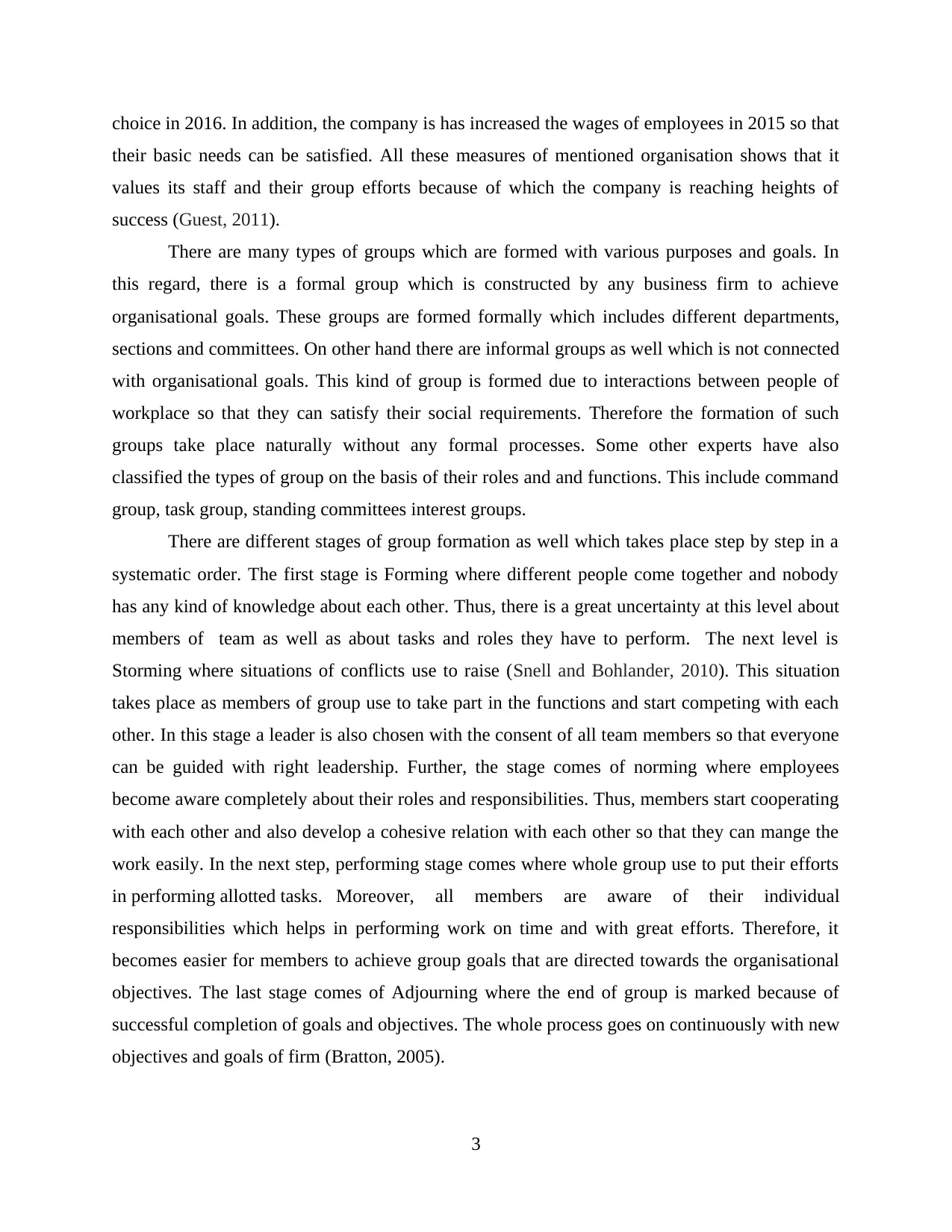
choice in 2016. In addition, the company is has increased the wages of employees in 2015 so that
their basic needs can be satisfied. All these measures of mentioned organisation shows that it
values its staff and their group efforts because of which the company is reaching heights of
success (Guest, 2011).
There are many types of groups which are formed with various purposes and goals. In
this regard, there is a formal group which is constructed by any business firm to achieve
organisational goals. These groups are formed formally which includes different departments,
sections and committees. On other hand there are informal groups as well which is not connected
with organisational goals. This kind of group is formed due to interactions between people of
workplace so that they can satisfy their social requirements. Therefore the formation of such
groups take place naturally without any formal processes. Some other experts have also
classified the types of group on the basis of their roles and and functions. This include command
group, task group, standing committees interest groups.
There are different stages of group formation as well which takes place step by step in a
systematic order. The first stage is Forming where different people come together and nobody
has any kind of knowledge about each other. Thus, there is a great uncertainty at this level about
members of team as well as about tasks and roles they have to perform. The next level is
Storming where situations of conflicts use to raise (Snell and Bohlander, 2010). This situation
takes place as members of group use to take part in the functions and start competing with each
other. In this stage a leader is also chosen with the consent of all team members so that everyone
can be guided with right leadership. Further, the stage comes of norming where employees
become aware completely about their roles and responsibilities. Thus, members start cooperating
with each other and also develop a cohesive relation with each other so that they can mange the
work easily. In the next step, performing stage comes where whole group use to put their efforts
in performing allotted tasks. Moreover, all members are aware of their individual
responsibilities which helps in performing work on time and with great efforts. Therefore, it
becomes easier for members to achieve group goals that are directed towards the organisational
objectives. The last stage comes of Adjourning where the end of group is marked because of
successful completion of goals and objectives. The whole process goes on continuously with new
objectives and goals of firm (Bratton, 2005).
3
their basic needs can be satisfied. All these measures of mentioned organisation shows that it
values its staff and their group efforts because of which the company is reaching heights of
success (Guest, 2011).
There are many types of groups which are formed with various purposes and goals. In
this regard, there is a formal group which is constructed by any business firm to achieve
organisational goals. These groups are formed formally which includes different departments,
sections and committees. On other hand there are informal groups as well which is not connected
with organisational goals. This kind of group is formed due to interactions between people of
workplace so that they can satisfy their social requirements. Therefore the formation of such
groups take place naturally without any formal processes. Some other experts have also
classified the types of group on the basis of their roles and and functions. This include command
group, task group, standing committees interest groups.
There are different stages of group formation as well which takes place step by step in a
systematic order. The first stage is Forming where different people come together and nobody
has any kind of knowledge about each other. Thus, there is a great uncertainty at this level about
members of team as well as about tasks and roles they have to perform. The next level is
Storming where situations of conflicts use to raise (Snell and Bohlander, 2010). This situation
takes place as members of group use to take part in the functions and start competing with each
other. In this stage a leader is also chosen with the consent of all team members so that everyone
can be guided with right leadership. Further, the stage comes of norming where employees
become aware completely about their roles and responsibilities. Thus, members start cooperating
with each other and also develop a cohesive relation with each other so that they can mange the
work easily. In the next step, performing stage comes where whole group use to put their efforts
in performing allotted tasks. Moreover, all members are aware of their individual
responsibilities which helps in performing work on time and with great efforts. Therefore, it
becomes easier for members to achieve group goals that are directed towards the organisational
objectives. The last stage comes of Adjourning where the end of group is marked because of
successful completion of goals and objectives. The whole process goes on continuously with new
objectives and goals of firm (Bratton, 2005).
3
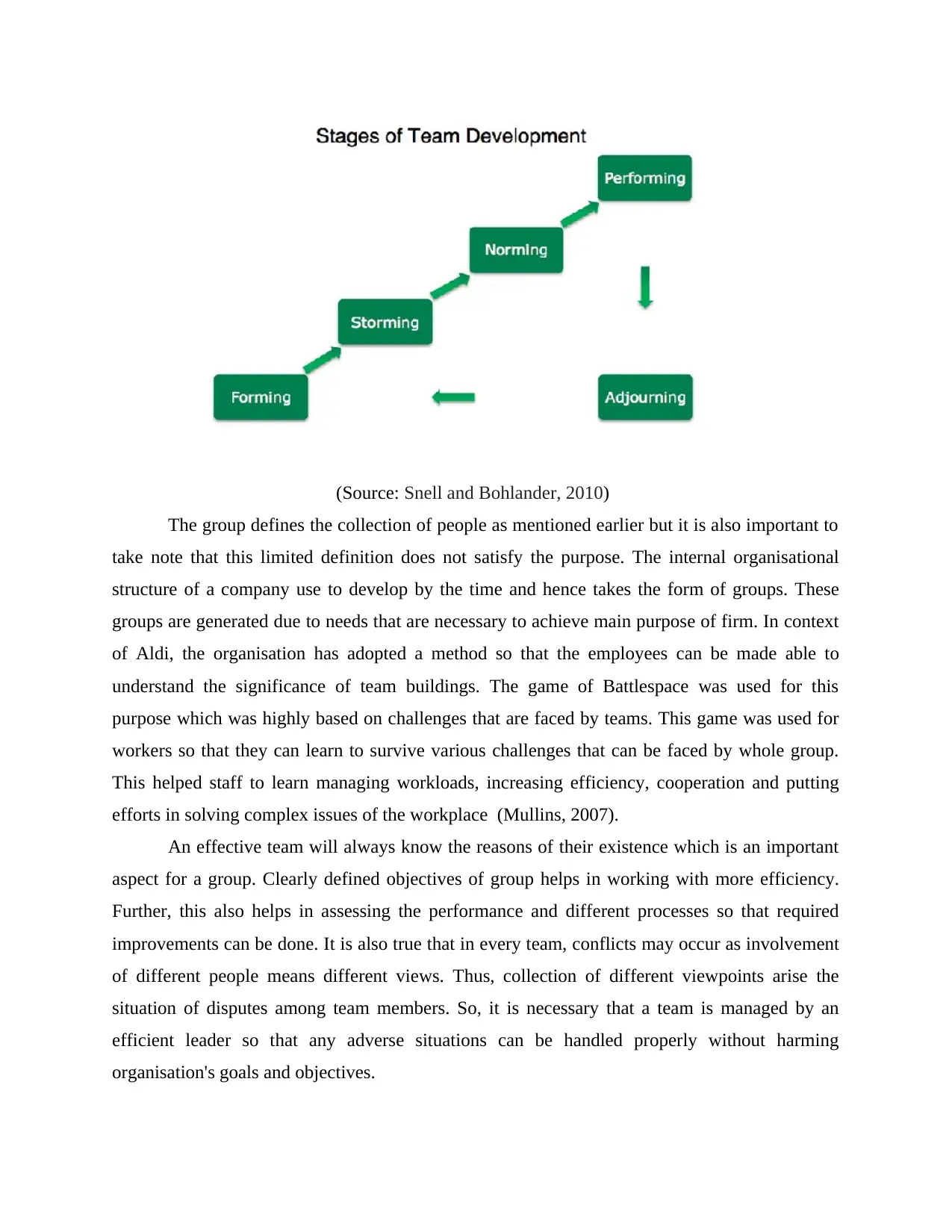
(Source: Snell and Bohlander, 2010)
The group defines the collection of people as mentioned earlier but it is also important to
take note that this limited definition does not satisfy the purpose. The internal organisational
structure of a company use to develop by the time and hence takes the form of groups. These
groups are generated due to needs that are necessary to achieve main purpose of firm. In context
of Aldi, the organisation has adopted a method so that the employees can be made able to
understand the significance of team buildings. The game of Battlespace was used for this
purpose which was highly based on challenges that are faced by teams. This game was used for
workers so that they can learn to survive various challenges that can be faced by whole group.
This helped staff to learn managing workloads, increasing efficiency, cooperation and putting
efforts in solving complex issues of the workplace (Mullins, 2007).
An effective team will always know the reasons of their existence which is an important
aspect for a group. Clearly defined objectives of group helps in working with more efficiency.
Further, this also helps in assessing the performance and different processes so that required
improvements can be done. It is also true that in every team, conflicts may occur as involvement
of different people means different views. Thus, collection of different viewpoints arise the
situation of disputes among team members. So, it is necessary that a team is managed by an
efficient leader so that any adverse situations can be handled properly without harming
organisation's goals and objectives.
The group defines the collection of people as mentioned earlier but it is also important to
take note that this limited definition does not satisfy the purpose. The internal organisational
structure of a company use to develop by the time and hence takes the form of groups. These
groups are generated due to needs that are necessary to achieve main purpose of firm. In context
of Aldi, the organisation has adopted a method so that the employees can be made able to
understand the significance of team buildings. The game of Battlespace was used for this
purpose which was highly based on challenges that are faced by teams. This game was used for
workers so that they can learn to survive various challenges that can be faced by whole group.
This helped staff to learn managing workloads, increasing efficiency, cooperation and putting
efforts in solving complex issues of the workplace (Mullins, 2007).
An effective team will always know the reasons of their existence which is an important
aspect for a group. Clearly defined objectives of group helps in working with more efficiency.
Further, this also helps in assessing the performance and different processes so that required
improvements can be done. It is also true that in every team, conflicts may occur as involvement
of different people means different views. Thus, collection of different viewpoints arise the
situation of disputes among team members. So, it is necessary that a team is managed by an
efficient leader so that any adverse situations can be handled properly without harming
organisation's goals and objectives.
⊘ This is a preview!⊘
Do you want full access?
Subscribe today to unlock all pages.

Trusted by 1+ million students worldwide
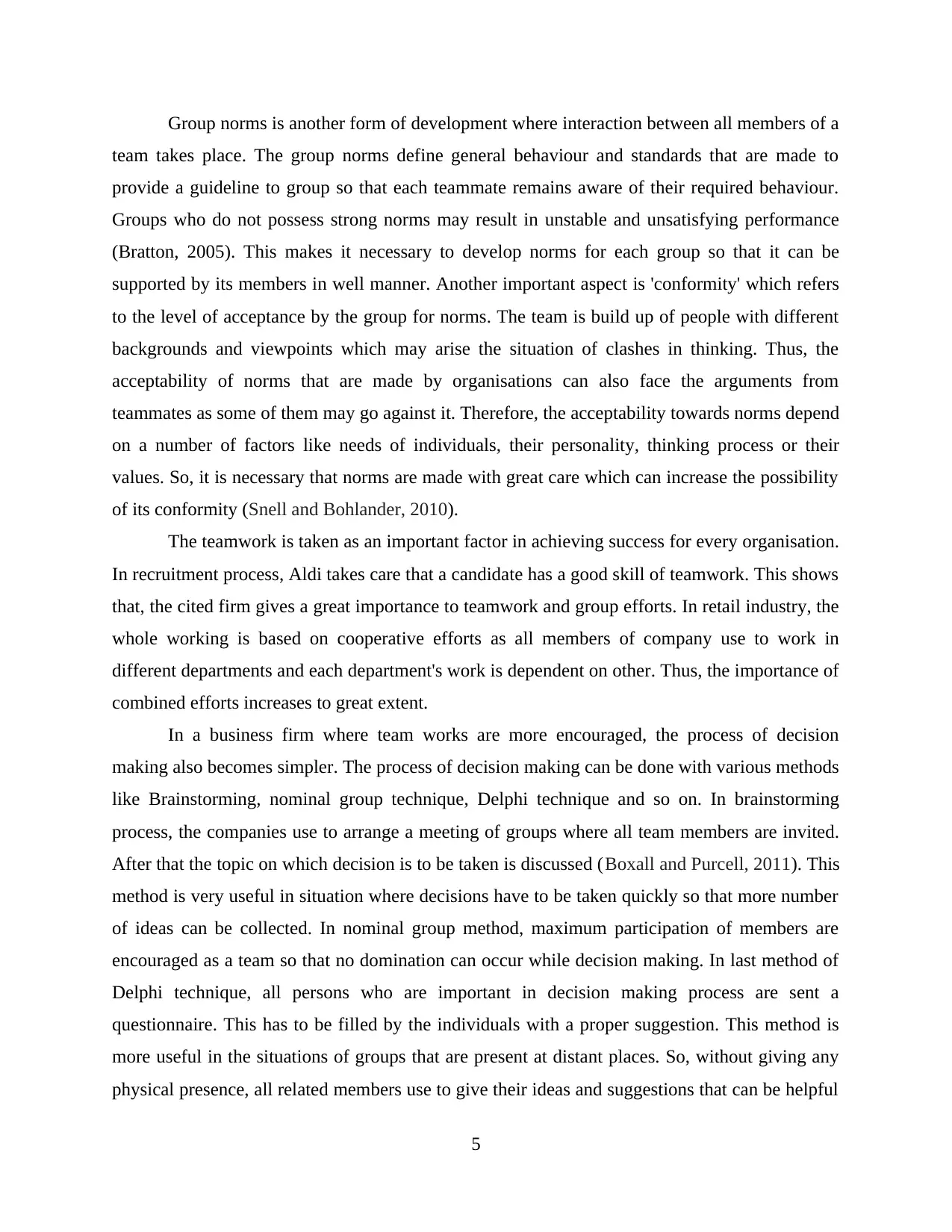
Group norms is another form of development where interaction between all members of a
team takes place. The group norms define general behaviour and standards that are made to
provide a guideline to group so that each teammate remains aware of their required behaviour.
Groups who do not possess strong norms may result in unstable and unsatisfying performance
(Bratton, 2005). This makes it necessary to develop norms for each group so that it can be
supported by its members in well manner. Another important aspect is 'conformity' which refers
to the level of acceptance by the group for norms. The team is build up of people with different
backgrounds and viewpoints which may arise the situation of clashes in thinking. Thus, the
acceptability of norms that are made by organisations can also face the arguments from
teammates as some of them may go against it. Therefore, the acceptability towards norms depend
on a number of factors like needs of individuals, their personality, thinking process or their
values. So, it is necessary that norms are made with great care which can increase the possibility
of its conformity (Snell and Bohlander, 2010).
The teamwork is taken as an important factor in achieving success for every organisation.
In recruitment process, Aldi takes care that a candidate has a good skill of teamwork. This shows
that, the cited firm gives a great importance to teamwork and group efforts. In retail industry, the
whole working is based on cooperative efforts as all members of company use to work in
different departments and each department's work is dependent on other. Thus, the importance of
combined efforts increases to great extent.
In a business firm where team works are more encouraged, the process of decision
making also becomes simpler. The process of decision making can be done with various methods
like Brainstorming, nominal group technique, Delphi technique and so on. In brainstorming
process, the companies use to arrange a meeting of groups where all team members are invited.
After that the topic on which decision is to be taken is discussed (Boxall and Purcell, 2011). This
method is very useful in situation where decisions have to be taken quickly so that more number
of ideas can be collected. In nominal group method, maximum participation of members are
encouraged as a team so that no domination can occur while decision making. In last method of
Delphi technique, all persons who are important in decision making process are sent a
questionnaire. This has to be filled by the individuals with a proper suggestion. This method is
more useful in the situations of groups that are present at distant places. So, without giving any
physical presence, all related members use to give their ideas and suggestions that can be helpful
5
team takes place. The group norms define general behaviour and standards that are made to
provide a guideline to group so that each teammate remains aware of their required behaviour.
Groups who do not possess strong norms may result in unstable and unsatisfying performance
(Bratton, 2005). This makes it necessary to develop norms for each group so that it can be
supported by its members in well manner. Another important aspect is 'conformity' which refers
to the level of acceptance by the group for norms. The team is build up of people with different
backgrounds and viewpoints which may arise the situation of clashes in thinking. Thus, the
acceptability of norms that are made by organisations can also face the arguments from
teammates as some of them may go against it. Therefore, the acceptability towards norms depend
on a number of factors like needs of individuals, their personality, thinking process or their
values. So, it is necessary that norms are made with great care which can increase the possibility
of its conformity (Snell and Bohlander, 2010).
The teamwork is taken as an important factor in achieving success for every organisation.
In recruitment process, Aldi takes care that a candidate has a good skill of teamwork. This shows
that, the cited firm gives a great importance to teamwork and group efforts. In retail industry, the
whole working is based on cooperative efforts as all members of company use to work in
different departments and each department's work is dependent on other. Thus, the importance of
combined efforts increases to great extent.
In a business firm where team works are more encouraged, the process of decision
making also becomes simpler. The process of decision making can be done with various methods
like Brainstorming, nominal group technique, Delphi technique and so on. In brainstorming
process, the companies use to arrange a meeting of groups where all team members are invited.
After that the topic on which decision is to be taken is discussed (Boxall and Purcell, 2011). This
method is very useful in situation where decisions have to be taken quickly so that more number
of ideas can be collected. In nominal group method, maximum participation of members are
encouraged as a team so that no domination can occur while decision making. In last method of
Delphi technique, all persons who are important in decision making process are sent a
questionnaire. This has to be filled by the individuals with a proper suggestion. This method is
more useful in the situations of groups that are present at distant places. So, without giving any
physical presence, all related members use to give their ideas and suggestions that can be helpful
5
Paraphrase This Document
Need a fresh take? Get an instant paraphrase of this document with our AI Paraphraser
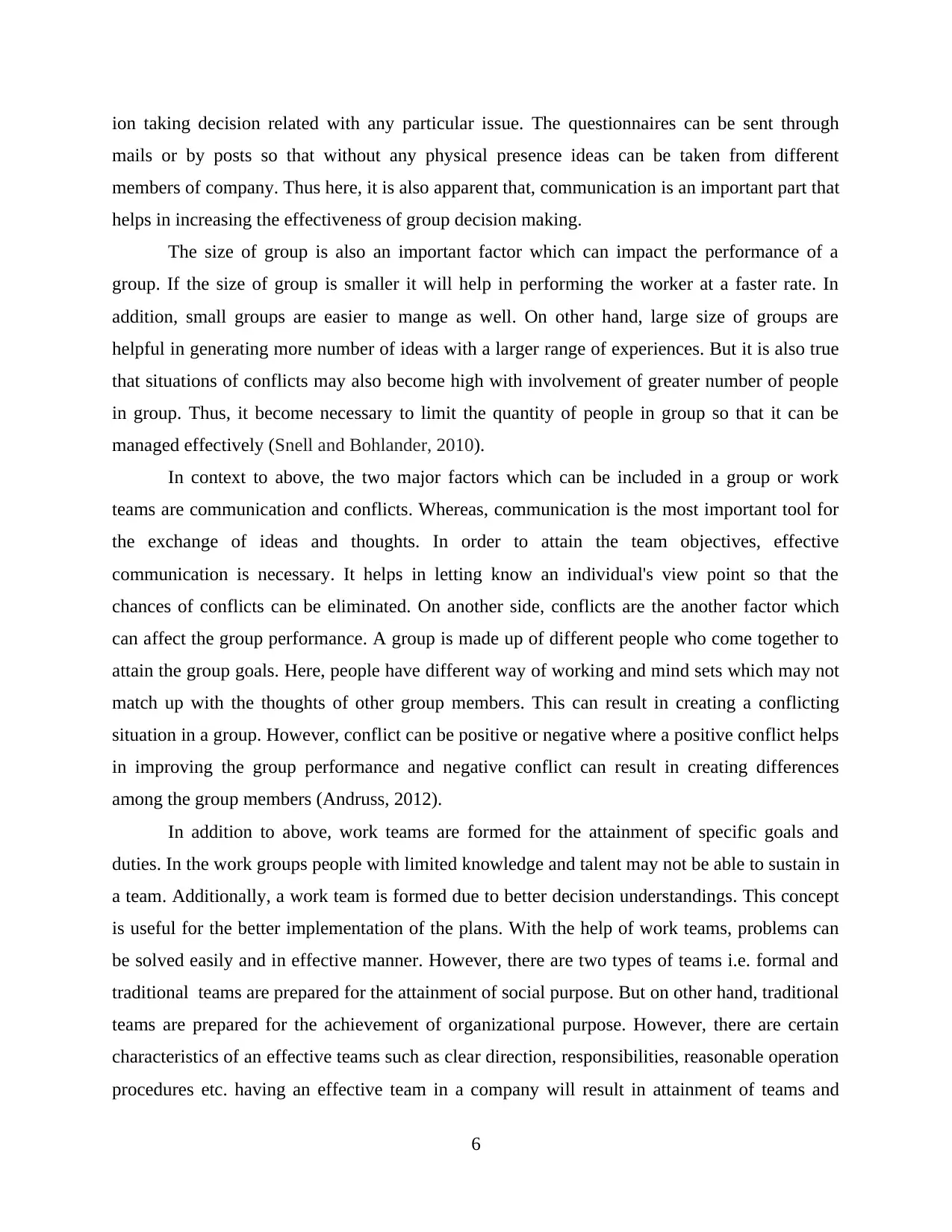
ion taking decision related with any particular issue. The questionnaires can be sent through
mails or by posts so that without any physical presence ideas can be taken from different
members of company. Thus here, it is also apparent that, communication is an important part that
helps in increasing the effectiveness of group decision making.
The size of group is also an important factor which can impact the performance of a
group. If the size of group is smaller it will help in performing the worker at a faster rate. In
addition, small groups are easier to mange as well. On other hand, large size of groups are
helpful in generating more number of ideas with a larger range of experiences. But it is also true
that situations of conflicts may also become high with involvement of greater number of people
in group. Thus, it become necessary to limit the quantity of people in group so that it can be
managed effectively (Snell and Bohlander, 2010).
In context to above, the two major factors which can be included in a group or work
teams are communication and conflicts. Whereas, communication is the most important tool for
the exchange of ideas and thoughts. In order to attain the team objectives, effective
communication is necessary. It helps in letting know an individual's view point so that the
chances of conflicts can be eliminated. On another side, conflicts are the another factor which
can affect the group performance. A group is made up of different people who come together to
attain the group goals. Here, people have different way of working and mind sets which may not
match up with the thoughts of other group members. This can result in creating a conflicting
situation in a group. However, conflict can be positive or negative where a positive conflict helps
in improving the group performance and negative conflict can result in creating differences
among the group members (Andruss, 2012).
In addition to above, work teams are formed for the attainment of specific goals and
duties. In the work groups people with limited knowledge and talent may not be able to sustain in
a team. Additionally, a work team is formed due to better decision understandings. This concept
is useful for the better implementation of the plans. With the help of work teams, problems can
be solved easily and in effective manner. However, there are two types of teams i.e. formal and
traditional teams are prepared for the attainment of social purpose. But on other hand, traditional
teams are prepared for the achievement of organizational purpose. However, there are certain
characteristics of an effective teams such as clear direction, responsibilities, reasonable operation
procedures etc. having an effective team in a company will result in attainment of teams and
6
mails or by posts so that without any physical presence ideas can be taken from different
members of company. Thus here, it is also apparent that, communication is an important part that
helps in increasing the effectiveness of group decision making.
The size of group is also an important factor which can impact the performance of a
group. If the size of group is smaller it will help in performing the worker at a faster rate. In
addition, small groups are easier to mange as well. On other hand, large size of groups are
helpful in generating more number of ideas with a larger range of experiences. But it is also true
that situations of conflicts may also become high with involvement of greater number of people
in group. Thus, it become necessary to limit the quantity of people in group so that it can be
managed effectively (Snell and Bohlander, 2010).
In context to above, the two major factors which can be included in a group or work
teams are communication and conflicts. Whereas, communication is the most important tool for
the exchange of ideas and thoughts. In order to attain the team objectives, effective
communication is necessary. It helps in letting know an individual's view point so that the
chances of conflicts can be eliminated. On another side, conflicts are the another factor which
can affect the group performance. A group is made up of different people who come together to
attain the group goals. Here, people have different way of working and mind sets which may not
match up with the thoughts of other group members. This can result in creating a conflicting
situation in a group. However, conflict can be positive or negative where a positive conflict helps
in improving the group performance and negative conflict can result in creating differences
among the group members (Andruss, 2012).
In addition to above, work teams are formed for the attainment of specific goals and
duties. In the work groups people with limited knowledge and talent may not be able to sustain in
a team. Additionally, a work team is formed due to better decision understandings. This concept
is useful for the better implementation of the plans. With the help of work teams, problems can
be solved easily and in effective manner. However, there are two types of teams i.e. formal and
traditional teams are prepared for the attainment of social purpose. But on other hand, traditional
teams are prepared for the achievement of organizational purpose. However, there are certain
characteristics of an effective teams such as clear direction, responsibilities, reasonable operation
procedures etc. having an effective team in a company will result in attainment of teams and
6
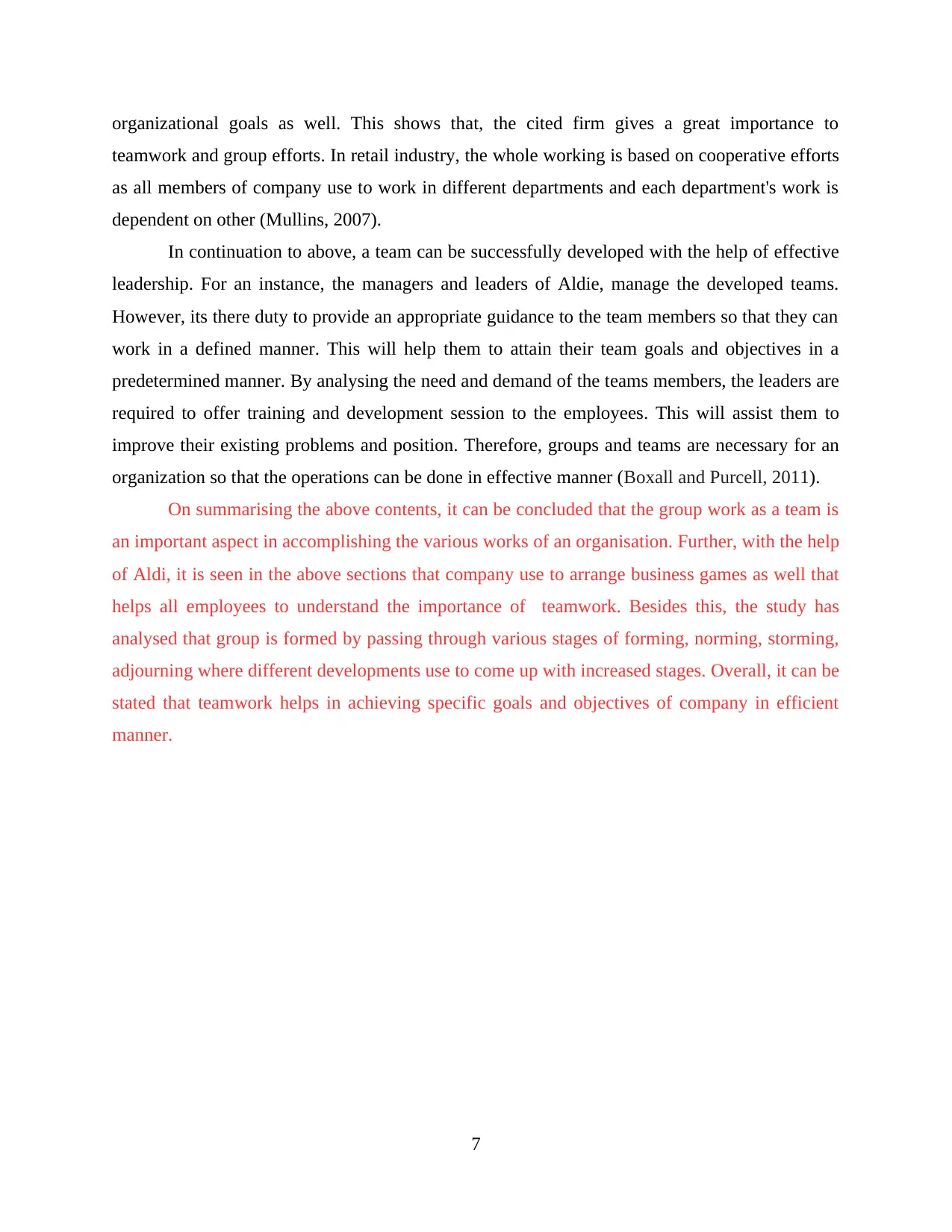
organizational goals as well. This shows that, the cited firm gives a great importance to
teamwork and group efforts. In retail industry, the whole working is based on cooperative efforts
as all members of company use to work in different departments and each department's work is
dependent on other (Mullins, 2007).
In continuation to above, a team can be successfully developed with the help of effective
leadership. For an instance, the managers and leaders of Aldie, manage the developed teams.
However, its there duty to provide an appropriate guidance to the team members so that they can
work in a defined manner. This will help them to attain their team goals and objectives in a
predetermined manner. By analysing the need and demand of the teams members, the leaders are
required to offer training and development session to the employees. This will assist them to
improve their existing problems and position. Therefore, groups and teams are necessary for an
organization so that the operations can be done in effective manner (Boxall and Purcell, 2011).
On summarising the above contents, it can be concluded that the group work as a team is
an important aspect in accomplishing the various works of an organisation. Further, with the help
of Aldi, it is seen in the above sections that company use to arrange business games as well that
helps all employees to understand the importance of teamwork. Besides this, the study has
analysed that group is formed by passing through various stages of forming, norming, storming,
adjourning where different developments use to come up with increased stages. Overall, it can be
stated that teamwork helps in achieving specific goals and objectives of company in efficient
manner.
7
teamwork and group efforts. In retail industry, the whole working is based on cooperative efforts
as all members of company use to work in different departments and each department's work is
dependent on other (Mullins, 2007).
In continuation to above, a team can be successfully developed with the help of effective
leadership. For an instance, the managers and leaders of Aldie, manage the developed teams.
However, its there duty to provide an appropriate guidance to the team members so that they can
work in a defined manner. This will help them to attain their team goals and objectives in a
predetermined manner. By analysing the need and demand of the teams members, the leaders are
required to offer training and development session to the employees. This will assist them to
improve their existing problems and position. Therefore, groups and teams are necessary for an
organization so that the operations can be done in effective manner (Boxall and Purcell, 2011).
On summarising the above contents, it can be concluded that the group work as a team is
an important aspect in accomplishing the various works of an organisation. Further, with the help
of Aldi, it is seen in the above sections that company use to arrange business games as well that
helps all employees to understand the importance of teamwork. Besides this, the study has
analysed that group is formed by passing through various stages of forming, norming, storming,
adjourning where different developments use to come up with increased stages. Overall, it can be
stated that teamwork helps in achieving specific goals and objectives of company in efficient
manner.
7
⊘ This is a preview!⊘
Do you want full access?
Subscribe today to unlock all pages.

Trusted by 1+ million students worldwide

8
Paraphrase This Document
Need a fresh take? Get an instant paraphrase of this document with our AI Paraphraser
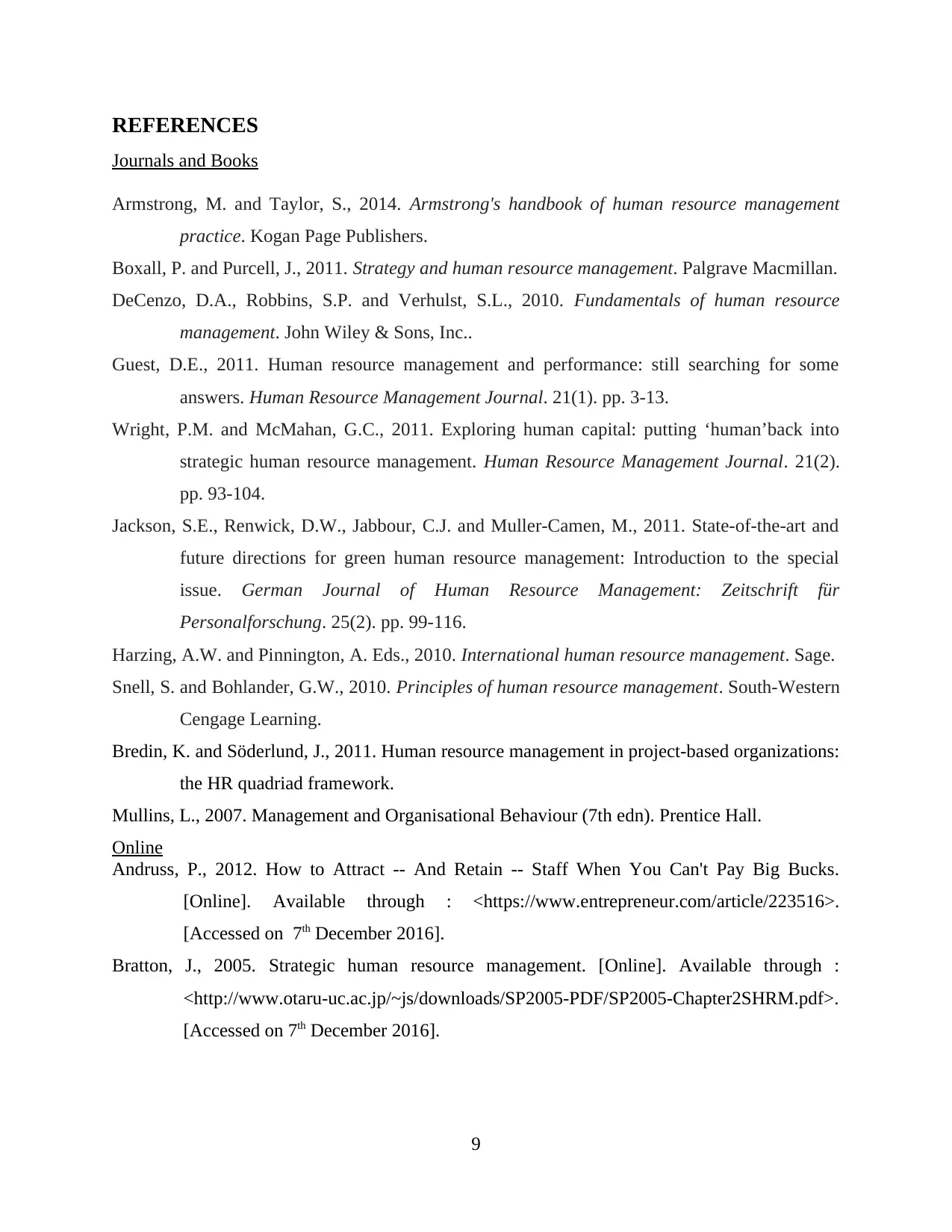
REFERENCES
Journals and Books
Armstrong, M. and Taylor, S., 2014. Armstrong's handbook of human resource management
practice. Kogan Page Publishers.
Boxall, P. and Purcell, J., 2011. Strategy and human resource management. Palgrave Macmillan.
DeCenzo, D.A., Robbins, S.P. and Verhulst, S.L., 2010. Fundamentals of human resource
management. John Wiley & Sons, Inc..
Guest, D.E., 2011. Human resource management and performance: still searching for some
answers. Human Resource Management Journal. 21(1). pp. 3-13.
Wright, P.M. and McMahan, G.C., 2011. Exploring human capital: putting ‘human’back into
strategic human resource management. Human Resource Management Journal. 21(2).
pp. 93-104.
Jackson, S.E., Renwick, D.W., Jabbour, C.J. and Muller-Camen, M., 2011. State-of-the-art and
future directions for green human resource management: Introduction to the special
issue. German Journal of Human Resource Management: Zeitschrift für
Personalforschung. 25(2). pp. 99-116.
Harzing, A.W. and Pinnington, A. Eds., 2010. International human resource management. Sage.
Snell, S. and Bohlander, G.W., 2010. Principles of human resource management. South-Western
Cengage Learning.
Bredin, K. and Söderlund, J., 2011. Human resource management in project-based organizations:
the HR quadriad framework.
Mullins, L., 2007. Management and Organisational Behaviour (7th edn). Prentice Hall.
Online
Andruss, P., 2012. How to Attract -- And Retain -- Staff When You Can't Pay Big Bucks.
[Online]. Available through : <https://www.entrepreneur.com/article/223516>.
[Accessed on 7th December 2016].
Bratton, J., 2005. Strategic human resource management. [Online]. Available through :
<http://www.otaru-uc.ac.jp/~js/downloads/SP2005-PDF/SP2005-Chapter2SHRM.pdf>.
[Accessed on 7th December 2016].
9
Journals and Books
Armstrong, M. and Taylor, S., 2014. Armstrong's handbook of human resource management
practice. Kogan Page Publishers.
Boxall, P. and Purcell, J., 2011. Strategy and human resource management. Palgrave Macmillan.
DeCenzo, D.A., Robbins, S.P. and Verhulst, S.L., 2010. Fundamentals of human resource
management. John Wiley & Sons, Inc..
Guest, D.E., 2011. Human resource management and performance: still searching for some
answers. Human Resource Management Journal. 21(1). pp. 3-13.
Wright, P.M. and McMahan, G.C., 2011. Exploring human capital: putting ‘human’back into
strategic human resource management. Human Resource Management Journal. 21(2).
pp. 93-104.
Jackson, S.E., Renwick, D.W., Jabbour, C.J. and Muller-Camen, M., 2011. State-of-the-art and
future directions for green human resource management: Introduction to the special
issue. German Journal of Human Resource Management: Zeitschrift für
Personalforschung. 25(2). pp. 99-116.
Harzing, A.W. and Pinnington, A. Eds., 2010. International human resource management. Sage.
Snell, S. and Bohlander, G.W., 2010. Principles of human resource management. South-Western
Cengage Learning.
Bredin, K. and Söderlund, J., 2011. Human resource management in project-based organizations:
the HR quadriad framework.
Mullins, L., 2007. Management and Organisational Behaviour (7th edn). Prentice Hall.
Online
Andruss, P., 2012. How to Attract -- And Retain -- Staff When You Can't Pay Big Bucks.
[Online]. Available through : <https://www.entrepreneur.com/article/223516>.
[Accessed on 7th December 2016].
Bratton, J., 2005. Strategic human resource management. [Online]. Available through :
<http://www.otaru-uc.ac.jp/~js/downloads/SP2005-PDF/SP2005-Chapter2SHRM.pdf>.
[Accessed on 7th December 2016].
9
1 out of 11
Related Documents
Your All-in-One AI-Powered Toolkit for Academic Success.
+13062052269
info@desklib.com
Available 24*7 on WhatsApp / Email
![[object Object]](/_next/static/media/star-bottom.7253800d.svg)
Unlock your academic potential
Copyright © 2020–2025 A2Z Services. All Rights Reserved. Developed and managed by ZUCOL.





